Cassowaries are flightless birds with an impressive presence. They’re one of the biggest birds on the planet and can grow to almost 6 feet tall! These ancient birds are adapted to running, walking, and swimming. Instead of flying with their wings, they use them to glide through the water at top speeds. Are you ready to discover more about these fascinating birds? Read on to learn 10 incredible cassowary facts.

1. Cassowaries Talk With Infrasonic Booms
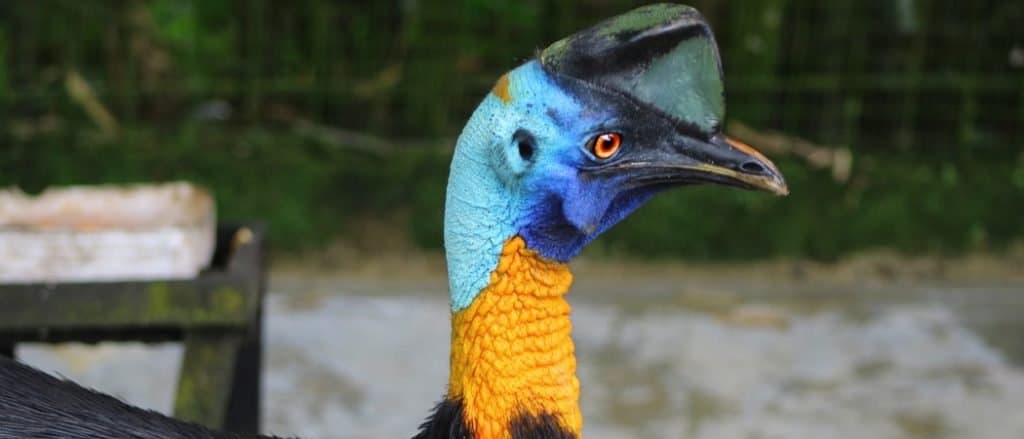
Cassowary can communicate with infrasonic booms.
©RonnyDesign/Shutterstock.com
Our incredible cassowary facts start with their lifestyle! Cassowaries are usually solitary birds. However, the breeding season brings out a different side of them. When breeding season comes around, cassowaries will use infrasonic booms to communicate. They’ll also exhibit throat and neck swelling, high stepping, and head shaking to attract a mate. Cassowary booms are low-frequency sounds humans can’t hear, but available cassowary mates can. Even though humans can’t hear the booms, we can feel the low powerful rumble in our bones.
2. Cassowaries Belong to a Super Order of Birds

©Danny Ye/Shutterstock.com
Cassowaries belong to a particular order of birds called Palaeognathae. It’s one of the only living superorders of birds. This terrestrial bird group includes a variety of large, flightless species and smaller chicken-sized birds. Other species that belong to this bird group include ostriches, kiwis, tinamous, and rheas. However, not all flightless birds belong to the Palaeognathae group. For instance, penguins, rails, and puffins are classified as Neognathae.
3. They’re One of the Most Dangerous Birds Alive
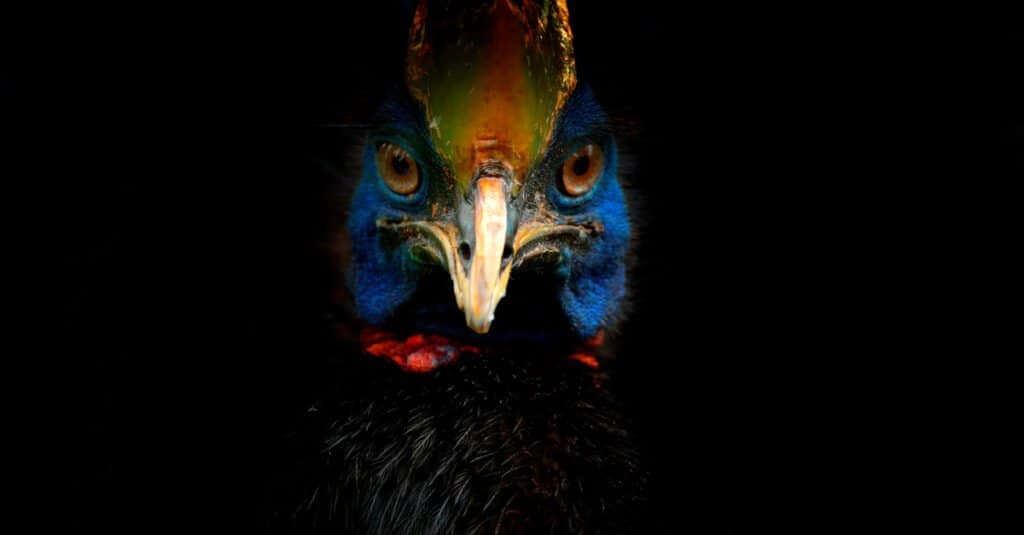
©Ondrej Prosicky/Shutterstock.com
Cassowaries have earned the title as one of the most dangerous birds in the world, and for a good reason too! All it takes is one swift kick for a cassowary to slice open a large predator. They have a sizeable three-toed foot with a razor-sharp claw on the inner toe. The dagger-like cassowary claw can be as long as 4 in! Their legs are powerful too. They can run 31 miles per hour and jump 7 ft straight in the air. The good news is that cassowaries don’t seek out people. Instead, these birds aren’t aggressive unless threatened. In fact, cassowaries are best described as shy.
4. They’re Insanely Hard to Study

Many cassowary populations inhabit New Guinea, where conservation and political issues interrupt research on these mysterious birds.
©Strelyuk/Shutterstock.com
It’s impressive that scientists are even able to uncover any incredible cassowary facts, considering they’re so hard to research. One of the reasons cassowaries are mysterious has to do with where they live.
A lot of the cassowary populations live in New Guinea. There are many conservation and political issues that interfere with research. That’s why there are unanswered questions about the cassowary’s evolutionary history, behavior, ecology, and biology.
On the mythological side of things, there are people in New Guinea who think that cassowaries are reincarnations of their female ancestors.
5. Scientists Are Puzzled by the Cassowary Horn
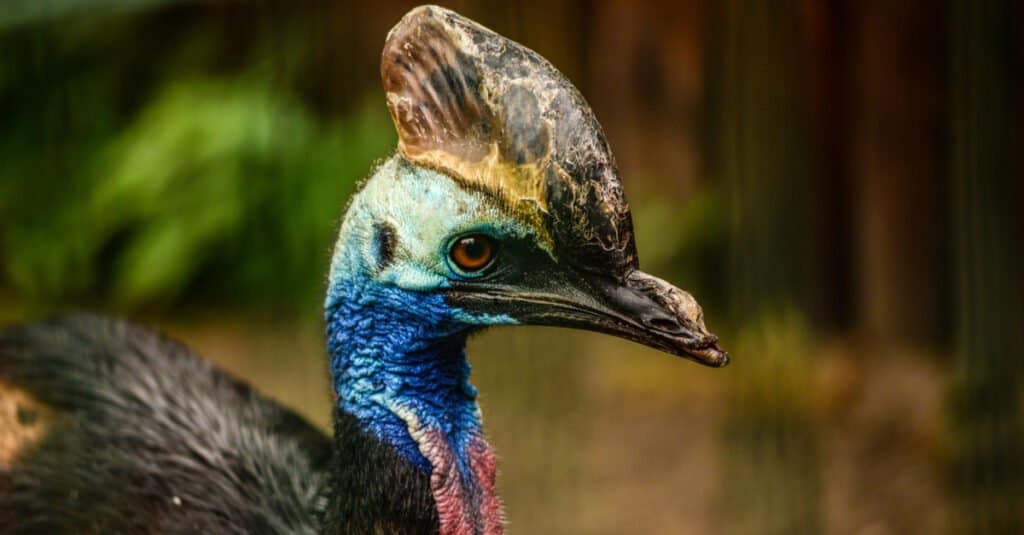
Cassowaries have a casque on top of their head.
©studioxy/Shutterstock.com
Cassowaries have some of the weirdest headgear in the animal kingdom! They have a special casque on the top of their head that’s sometimes called a helmet. The casque looks like a horn and is made of a spongy material that is covered in a keratinous sheet.
The casque is a mysterious part of their anatomy. Scientists are still unclear as to why they have it. Some believe the helmet is there to help protect their head when running at fast speeds. New research suggests that it might even have the capacity for thermal regulation. However, the cassowary helmet might be more cosmetic than anything else. It’s possible that cassowaries use their helmets to attract a mate, similar to a peacock’s tail. It may be that the larger the helmet, the more attractive the cassowary is. The only clear thing is that the horn is how they got their name. The word cassowary is of Papuan origin. “Kasu” means horned, and “weri” means head.
6. They Can Live For More Than 50 Years
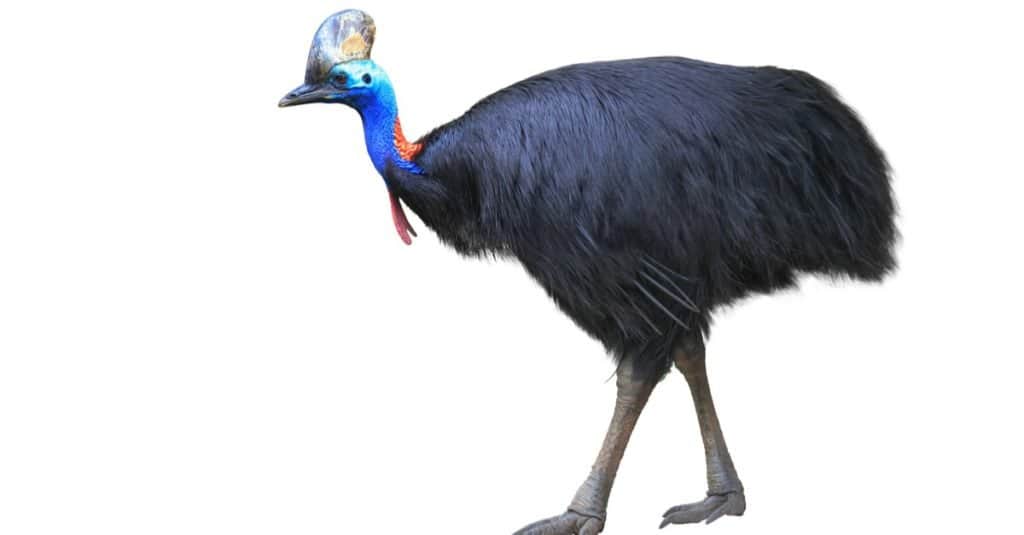
Cassowaries can live up to 60 years in captivity, but their lifespan in the wild is unclear.
©Sanit Fuangnakhon/Shutterstock.com
In captivity, a cassowary can live as long as 60 years! However, in the wilderness, it’s unclear how long these birds can last. For a cassowary to have a long life in captivity, it must be taken care of by an expert. Their diet is one of the most important aspects of caring for these large birds in captivity.
Cassowaries are omnivores; they eat a diet consisting of fruit, insects, reptiles, and small mammals. Sometimes they’re even referred to as frugivores because of their fondness for fruit. However, when a cassowary has a high protein craving, it’ll need reptiles or small mammals to get the proper nutrients. They also love snails and a variety of fungi.
7. Cassowaries Lay Green Eggs
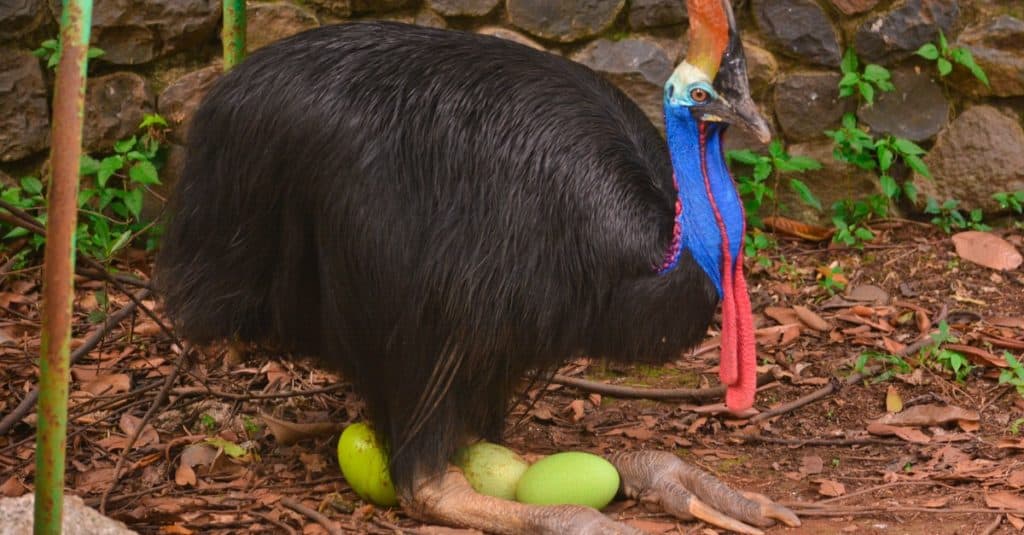
The eggs of a Southern cassowary are green in color.
©lucky vectorstudio/Shutterstock.com
Southern cassowaries lay green eggs! There are three cassowary species: dwarf, northern, and southern cassowary. There was a fourth species, the pygmy cassowary, but they’re extinct. Southern cassowaries have an impressive reputation for laying camouflaged eggs. The eggs are a vibrant greenish color thanks to a special pigment (biliverdin) found in the shells. The pigment is standard in a lot of bird eggshells.
8. Cassowaries Nest on the Ground

Cassowaries are ground-nesting birds that use hollow depressions to lay their eggs in.
©iStock.com/DannyIacob
Next on our list of incredible cassowary facts, they have unusual nesting spots. Some birds use treetops to escape ground predators, but not cassowaries. Cassowaries are ground-nesting birds. Rather than building a nest, they use a hollow depression on the ground for their eggs. Sometimes the eggs are as large as 5 inches! The male cassowary will sit on the giant eggs for about two months, keeping hungry predators away. Predators of the eggs include quolls, dingoes, pythons, and crocodiles.
9. Male Cassowaries Are in Charge

Cassowary in the tropical forest
©HAFIZULLAHYATIM/Shutterstock.com
When baby cassowaries emerge from their eggs, they stay with their dad instead of their mom. The youngsters will stay with their father for around 9 to 10 months. After that time, the dad chases the young ones away to live independently. By the time the father chases the young away, they’re usually at adult size. However, in some situations, the young cassowaries don’t want to leave their father. Some young cassowaries will stick around for as long as 16 months.
10. They Have a Wattle
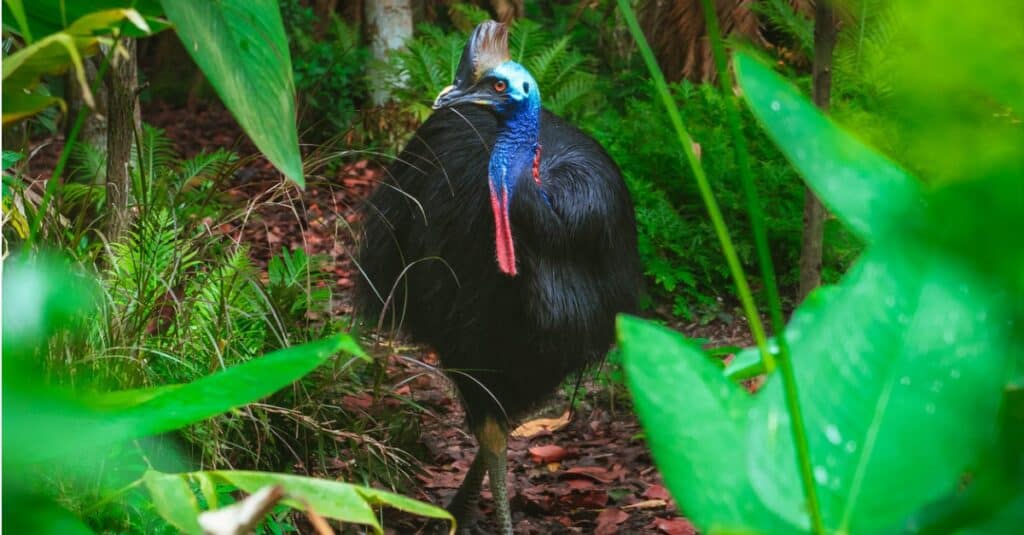
Similar to turkeys, the cassowary has a wattle.
©iStock.com/Henry Soon
Gobble gobble! Last on our list of incredible cassowary facts is that they have a wattle, just like a turkey does! Wattles are the wrinkly, bumpy-looking red skin that hangs from their chin. Only two of the three cassowary species have these fleshy pouches hanging from their neck; the southern and double-wattled cassowaries. The fleshy pouches have a bright blue, red, purple, gold, or white color. The color of the wattle helps identify the cassowary subspecies. It may also help express the cassowary’s mood. It’s also possible that the wattles help cassowaries provide social cues. Bees, penguins, and wolves also communicate with particular social cues.
The photo featured at the top of this post is © Ondrej Prosicky/Shutterstock.com
Thank you for reading! Have some feedback for us? Contact the AZ Animals editorial team.






